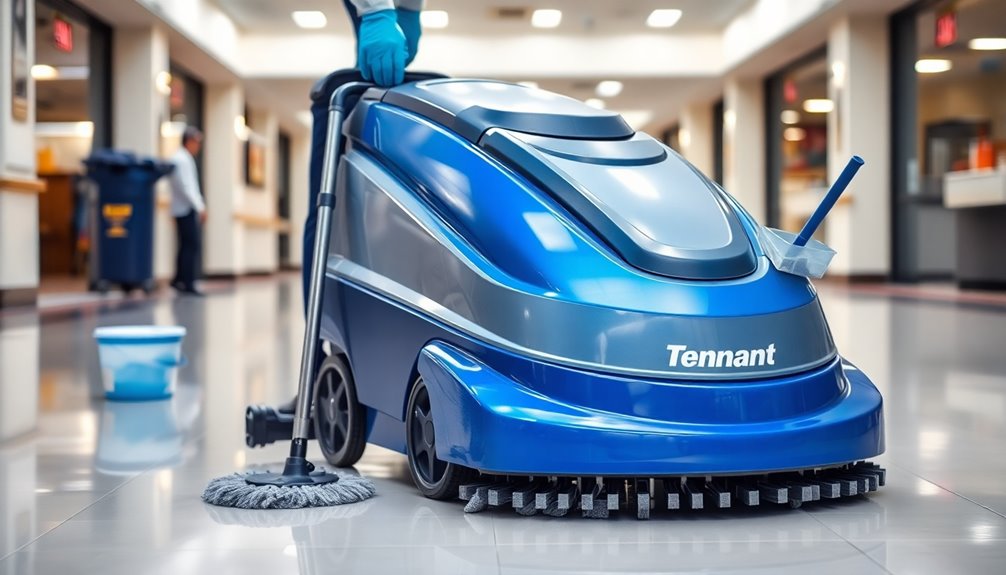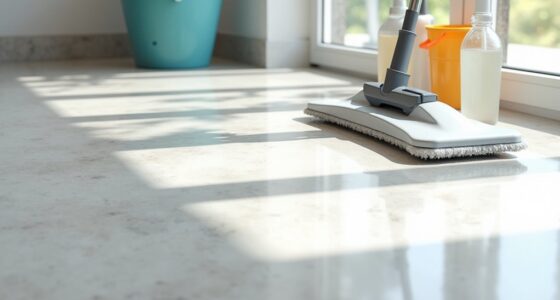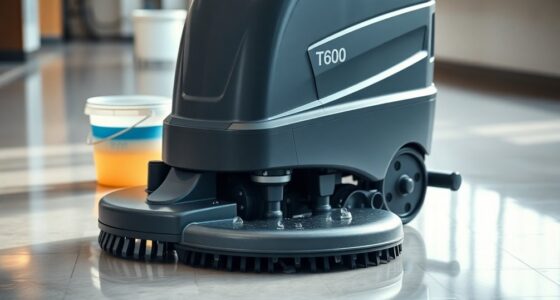To use a Tennant floor scrubber, start by clearing the floor of debris and checking the solution and recovery tanks. Adjust the brush pressure and solution flow for your floor type. Turn on the machine, activate the scrub functions, and maintain a steady pace while cleaning. Monitor the battery and recovery tank levels to prevent issues. After use, drain and clean the tanks. With these basics in mind, there's more to discover for effective operation.
Key Takeaways
- Prepare the machine by checking water levels, inspecting for damage, and familiarizing yourself with the control panel before use.
- Turn on the scrubber, select the appropriate settings, and adjust brush pressure based on floor conditions for effective cleaning.
- Begin scrubbing from the farthest corner, overlapping passes slightly to ensure complete coverage and avoid stepping on cleaned areas.
- Regularly monitor solution and waste tanks during operation, and use the vacuum feature to remove excess water for faster drying.
- After use, drain and clean the recovery tank and solution tank, and inspect brushes for wear before storing the machine.
Preparing the Floor Scrubber for Use

Before you start using the Tennant floor scrubber, make sure you've prepared it properly to guarantee top performance.
First, turn on the key switch and check that all scrub settings align with your cleaning needs. Inspect both the solution tank and recovery tank for any damage, making sure the covers seal tightly to prevent leaks during operation.
Next, verify that the battery fluid levels are adequate and that the batteries are fully charged. Don't forget to clean the vacuum fan inlet filter for ideal suction.
Finally, adjust the brush pressure and solution flow rate according to the floor conditions before you begin scrubbing, as this guarantees effective cleaning results and maximizes the scrubber's efficiency.
Adjusting Settings for Optimal Performance

Once you've prepared the Tennant floor scrubber, it's time to adjust the settings for ideal performance. Start by setting the brush pressure according to the floor type and grime level, which helps optimize cleaning and prolongs brush life. Next, adjust the solution flow rate—use lower rates for light cleaning and higher rates for heavily soiled areas. You can also utilize the one-step scrub button for preset functions tailored to specific tasks. Don't forget to check the battery discharge indicator and recharge as necessary. Finally, review your scrubbing routes to minimize stops, enhancing productivity.
| Setting | Recommendation | Purpose |
|---|---|---|
| Brush Pressure | High for heavy grime | Optimize cleaning power |
| Solution Flow Rate | Low for light cleaning | Prevent wastage |
| Scrub Functions | Use preset options | guarantee efficient operation |
| Battery Indicator | Recharge as needed | Maintain continuous use |
Operating the Scrubber
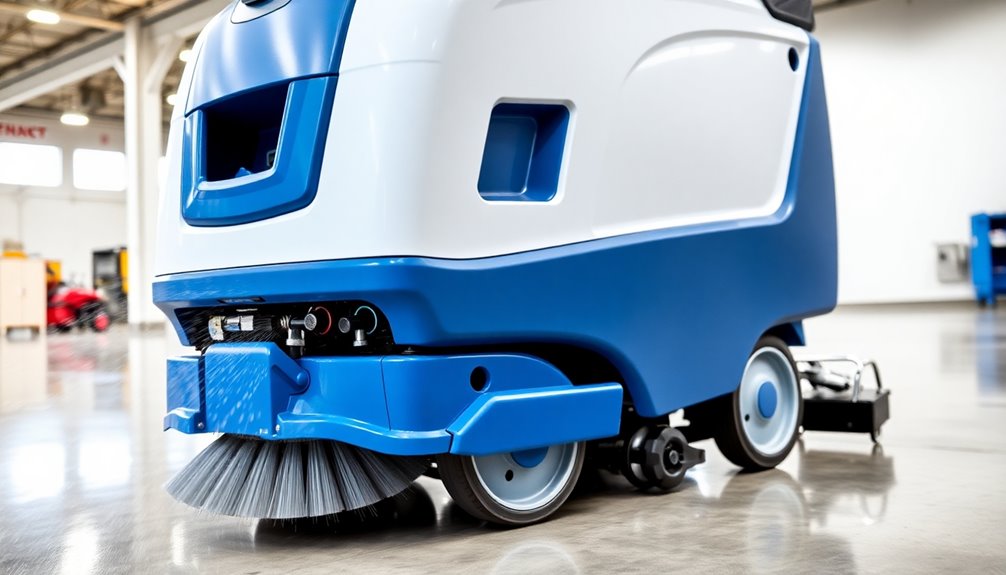
To operate the Tennant floor scrubber, simply turn on the key switch and verify your scrub settings are adjusted for the specific cleaning task.
Press the one-step scrub button to activate preset functions for scrubbing. Adjust the brush pressure and solution flow rate as needed during operation.
Use the propel pedal to control the machine's speed while steering with the wheel for effective navigation. Keep an eye on the battery discharge indicator to manage remaining charge levels; recharge after 30 minutes of use or more with the specified charger.
After cleaning, always drain the recovery tank and clean both the recovery tank and solution tank drain hoses to guarantee peak performance of your cleaning systems.
Monitoring Indicators During Operation
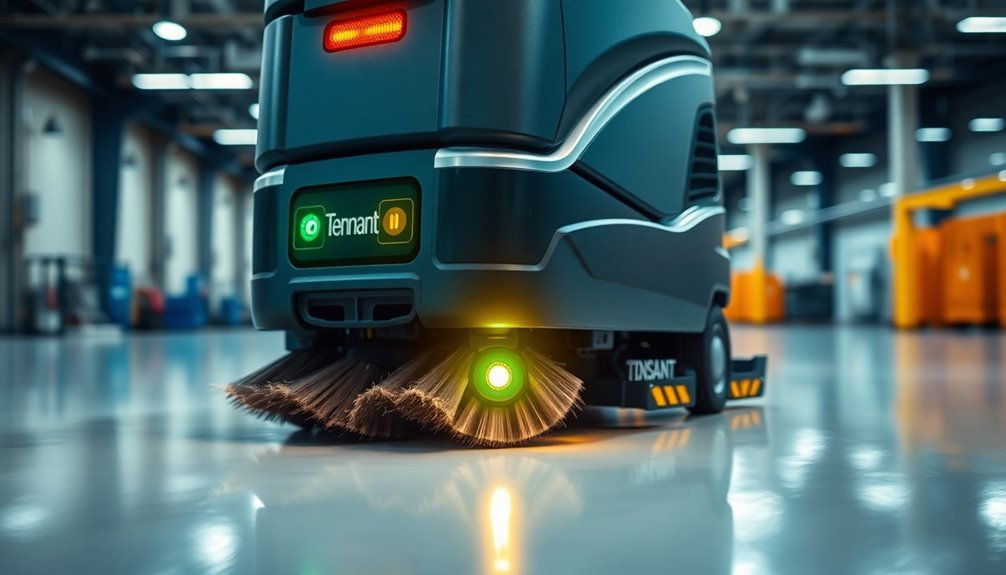
While you're using the Tennant floor scrubber, keep an eye on the battery discharge indicator to avoid losing power mid-clean.
The recovery tank full indicator will alert you when it's time to stop scrubbing to prevent overflow.
Also, watch for the fault indicator, as it signals any issues with the machine that need immediate attention.
Battery Discharge Indicator
Monitoring the battery discharge indicator is essential for the efficient operation of your Tennant floor scrubber. This indicator shows the remaining charge level, helping you manage usage time effectively. When it signals a low charge, it's time to recharge the batteries to avoid interruptions. If the level drops critically low, scrub functions will be disabled to protect the battery.
Here's a quick reference table for your convenience:
| Indicator Status | Action Required |
|---|---|
| Full Charge | Continue operation |
| 50% Charge | Monitor usage |
| 30% Charge | Prepare to recharge |
| Low Charge | Recharge the batteries soon |
| Critical Low Charge | Stop operation, recharge now |
Regularly checking the indicator helps maintain peak performance and guarantees your scrubber's always ready for use.
Recovery Tank Full
As you operate your Tennant floor scrubber, keeping an eye on the recovery tank full indicator is essential for maintaining efficient cleaning.
This indicator alerts you when the tank reaches maximum capacity, disabling scrub functions to prevent overflow.
To guarantee seamless operations, follow these steps:
- Regularly check the recovery tank status to avoid interruptions.
- When the indicator activates, immediately drain the tank using the drain hose to maintain effective scrubbing.
- Inspect and clean the drain hose periodically to prevent clogs and ensure the full indicator functions accurately.
Fault Indicator Alerts
Understanding the fault indicator on your Tennant floor scrubber is vital for maintaining ideal performance. This alert signals issues with the machine's motors, and if it illuminates, you should stop operation immediately to prevent further damage.
Regularly monitoring the fault indicator during use can help you identify problems early, ensuring timely maintenance and repair, which is essential for achieving best cleaning results. The fault indicator works alongside other operational indicators, like the battery discharge and recovery tank full indicators, to give you an extensive overview of your machine's performance.
Being familiar with the fault indicator's meaning and response procedures will enhance your safety and efficiency while using the Tennant floor scrubber.
Draining and Cleaning the Recovery Tank
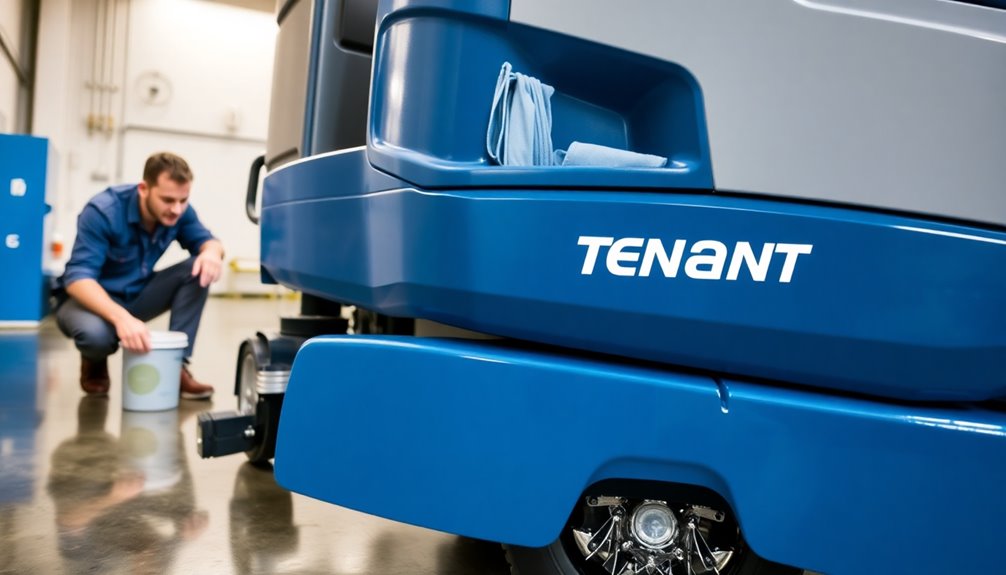
To keep your Tennant floor scrubber running efficiently, draining and cleaning the recovery tank is essential after each use. Follow these steps to guarantee proper maintenance:
- Check the indicator light or confirm cleaning is finished, then locate the drain hose and remove it to drain the dirty water.
- Clean both the recovery tank and solution tank drain hoses to prevent clogs. Rinse the float inside the recovery tank with clean water to avoid obstructions.
- Flush the inside of the recovery tank with clean water to remove any residual debris and contaminants.
Always reattach all hoses and securely close the covers after cleaning the recovery tank. This guarantees safety and functionality for your next cleaning session.
Proper Battery Charging Procedures
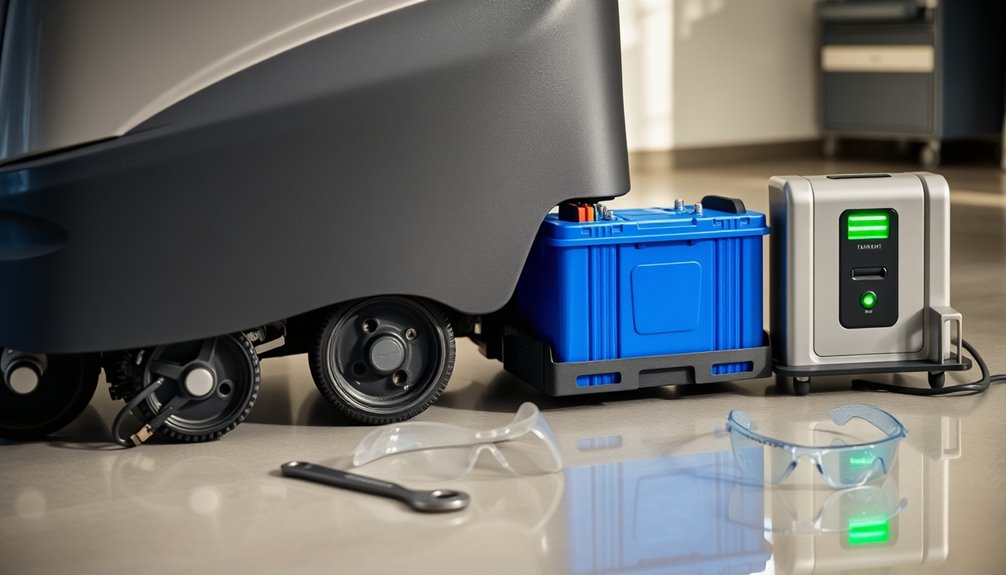
Maintaining your Tennant floor scrubber goes beyond just cleaning the recovery tank; proper battery charging is equally important for peak performance.
Always charge the batteries in a well-ventilated area to prevent hydrogen gas buildup. Before connecting the battery charger, verify the machine's on a level surface and the key switch is off to avoid electrical hazards.
Secure the seat latch to allow gas escape during charging. Never disconnect the DC cord while the charger operates; if you must interrupt, first disconnect the AC power supply cord.
Additionally, check the battery electrolyte levels before and after charging, adding distilled water as needed to maintain proper levels for maximum battery performance and verify your scrubber's water solution remains efficient.
Daily Maintenance and Safety Checks
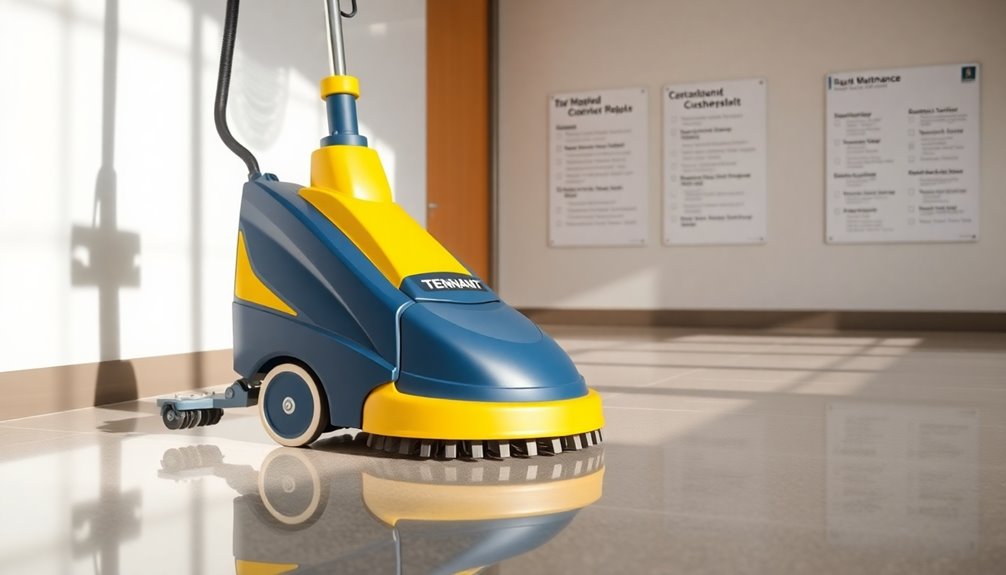
Before you start using your Tennant floor scrubber, performing daily maintenance and safety checks is essential to confirm it operates efficiently and safely.
Here's what you should check:
- Inspect the squeegee blade for damage and confirm proper deflection adjustment to effectively wipe up dirty solution during floor cleaning.
- Examine battery fluid and charge levels, adding distilled water if needed to prolong battery life and maintain performance.
- Clean the vacuum fan inlet filter and check tank cover seals for wear, confirming they're intact to prevent leaks.
These simple steps help maintain your scrubber's performance, confirming a cleaner, safer environment.
Regular checks keep your equipment in top shape and extend its lifespan.
Frequently Asked Questions
How to Start a Tennant Floor Scrubber?
To start the floor scrubber, first, turn on the key switch to power it up and check that the battery's charged and connected.
Next, confirm the scrub settings, like brush pressure and solution flow rate.
Press the one-step scrub button to activate the preset functions.
Use the directional switch to choose your travel direction and control the speed with the propel pedal.
Finally, make sure the recovery tank is empty and the solution tank's full.
How Do You Operate a Floor Scrubber?
Operating a floor scrubber's a breeze, kinda like riding a bike!
First, you'll turn on the key switch, then check your scrub settings. Hit the one-step scrub button to let the machine do its thing.
Adjust brush pressure and solution flow based on the floor's condition. Use the propel pedal to control speed and the directional switch for movement.
Don't forget to drain the recovery tank after you're done!
Why Is My Tennant Floor Scrubber Not Picking up Water?
If your floor scrubber isn't picking up water, check a few key areas.
First, inspect the squeegees for wear or damage; they need to be in good shape.
Make sure the recovery tank isn't full and that the vacuum fan inlet filter isn't clogged.
Also, verify that the solution tank has enough cleaning solution.
Finally, examine hoses and connections for leaks or disconnections that could be affecting suction.
How to Use Tennant Sweeper?
Imagine you're on a mission to keep your floors spotless. To use the sweeper, start by ensuring it's on a flat surface.
Flip the key switch, check the settings, and choose your direction with the switch. Control your speed with the pedal while keeping an eye on the battery indicator.
Press the scrub button, adjust brush pressure, and plan your route for efficiency.
Finally, clean the tank and recharge when you're done.
Conclusion
In conclusion, using a Tennant floor scrubber can make your cleaning routine a breeze. Remember, "a clean floor is a happy floor." By preparing your machine, adjusting settings, and following proper maintenance, you'll keep your space spotless and inviting. So, embrace the power of efficient cleaning and let your scrubber do the heavy lifting. With a little attention and care, you'll always be ready to tackle any mess that comes your way!
